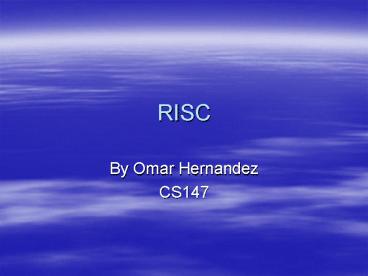RISC - PowerPoint PPT Presentation
1 / 38
Title:
RISC
Description:
CISC. Have large instruction sets that are close to higher language structures. Examples of CISC: ... RISC vs. CISC. Each type of processor has its benefits ... – PowerPoint PPT presentation
Number of Views:31
Avg rating:3.0/5.0
Title: RISC
1
RISC
- By Omar Hernandez
- CS147
2
Types of CPUs
- CISC
- RISC
3
Types of CPUs
- Complex
- Instruction
- Set
- Computers
- Reduced
- Instruction
- Set
- Computers
4
CISC
- Have large instruction sets that are close to
higher language structures - Examples of CISC
- Intels Pentium- class CPUs
- Motorola 68000 CPUs
5
RISC
- Reduced
- Instruction
- Set
- Computing
6
RISC
- Instruction set for RISC processors are
- Simple
- Pure Assembly language dedicated to the design of
the CPU
7
RISC Features
- Fixed length Instructions
- Limited Loading and Storing Instructions Access
Memory - Fewer Addressing Modes
- Instruction Pipeline
- Large Number of Registers
- Hardwired Control Unit
8
RISC Features (Contd)
- Delayed Loads and Branches
- Speculative Execution of Instructions
- Optimizing Compiler
- Separate Instruction and Data Streams
9
RISC Instruction Sets
- In general have only up to 100 instructions in
their set - Each instruction is capable of being executed in
a single clock cycle
10
RISC Instruction Sets (Contd)
- Basic Instructions include
- Data move (load, store, register move)
- Arithmetic
- Logic
- Shift
- Branch (jumps)
11
RISC Instruction Sets (Contd)
- RISC CPUs operate usually on two data types
- Integer
- Floating point
- Using different precisions or numbers of bits
within a given data type - Using these basic data types, you can program
into more complex data types
12
RISC Instruction Sets (Contd)
- RISC CPUs use different instruction formats
- Every instruction must have same amount of bits
regardless of format - CPU must be able to access each instruction code
in a single memory-read operation in order to
facilitate pipelining
13
RISC Instruction Sets (Contd)
- Instruction set usually has different types of
load and store due to bit alignment using from - 8 bit
- 16 bit
- 32 bit
- Etc.
14
RISC Instruction Sets (Contd)
- Addressing modes all depend on clock cycle
- Without it you would have to redesign pipeling
used to process instructions
15
RISC Instruction Sets (Contd)
- RISC II CPUs have
- 3 primary memory addressing modes
- Indexed address mode
- Register indirect address mode
- Contain a pseudoregister R0 thats always zero
16
RISC Performance
- RISC uses two techniques to improve performance
- Instruction Pipeline
- Register Window Renaming
17
RISC Performance (Contd)
- Instruction Pipeline
- Breaks down fetch-decode-execute process into
several instructions in parallel - Pipeline allows one instruction per clock cycle
18
Instruction Pipeline
19
Instruction Pipeline (Contd)
20
Instruction Pipeline (Contd)
21
Instruction Pipeline (Contd)
22
Instruction Pipeline (Contd)
- Speedup is the ratio of time needed to process n
instructions using nonpipelined control unit to
the time needed using a pipelined control unit
with the following formula
23
Instruction Pipeline (Contd)
- is time needed to process 1 instruction using
a nonpipelined control unit - is number of stages in pipeline
- is clock period of the pipeline
- Example
24
Instruction Pipeline Requirements
- RISC CPU must include cache memory that is at
least as fast as the pipeline - Cache must separate instructions and data to
avoid memory conflicts from stages of pipeline - Compiler has to be optimized to reorder
instructions in order to avoid problems with
branch instructions
25
Register Windowing Renaming
- Takes advantage of large amounts of registers
that RISC CPUs have - Producing more hits to register than memory
- Thus producing faster CPU performance
26
Types of registers
- Global register always accessible
- Windowed register a subset accessible at any
specific time
27
MIPS register organization
28
Register Renaming
- Makes use of any group of register with pointers
- Doesnt follow a register convention which
assigns registers to a certain task
29
Instruction Pipeline Conflicts
- Data Conflicts
- Software fixes
- No-op insertion
- Instruction reordering
- Hardware fix
- Stall insertion
- Data forwarding
- Branch Conflicts
30
Data Conflicts
31
No-Op Insertion
32
Instruction Reordering
33
Stall Insertion
34
Data Forwarding
35
Branch Conflicts
- Solutions
- No-op insertion
- Instruction reordering
- Annulling
- Branch prediction
36
Branch Conflicts (Contd)
- Annulling
- Instructions proceed through the pipeline as they
normally would. If an instruction should not have
been executed, because a previous instruction
branched away from it, its results are not stored.
37
Branch Conflicts (Contd)
- Branch Prediction
- Allows the compiler or pipeline hardware to make
an assumption as to whether or not the
conditional branch will be taken.
38
RISC vs. CISC
- Each type of processor has its benefits
- Depends what type of device to be built
- If its a small device
- RISC
- If its a large device
- CISC































